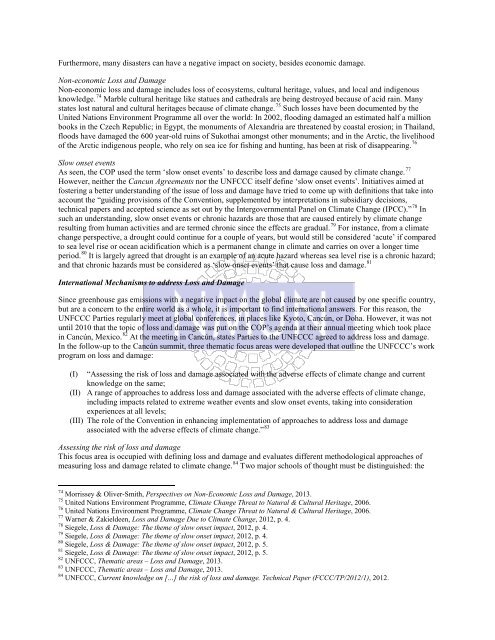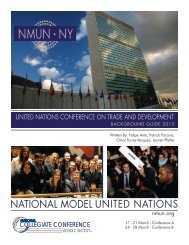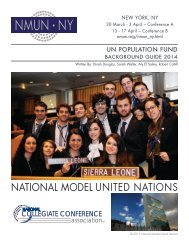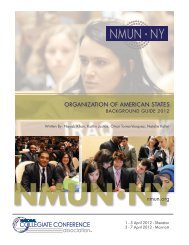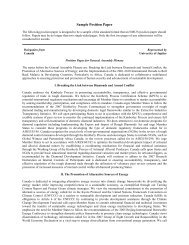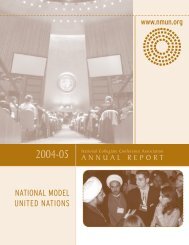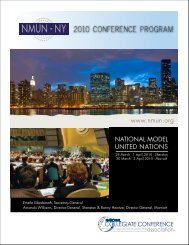NMUN • KOREA - National Model United Nations
NMUN • KOREA - National Model United Nations
NMUN • KOREA - National Model United Nations
Create successful ePaper yourself
Turn your PDF publications into a flip-book with our unique Google optimized e-Paper software.
Furthermore, many disasters can have a negative impact on society, besides economic damage.<br />
Non-economic Loss and Damage<br />
Non-economic loss and damage includes loss of ecosystems, cultural heritage, values, and local and indigenous<br />
knowledge. 74 Marble cultural heritage like statues and cathedrals are being destroyed because of acid rain. Many<br />
states lost natural and cultural heritages because of climate change. 75 Such losses have been documented by the<br />
<strong>United</strong> <strong>Nations</strong> Environment Programme all over the world: In 2002, flooding damaged an estimated half a million<br />
books in the Czech Republic; in Egypt, the monuments of Alexandria are threatened by coastal erosion; in Thailand,<br />
floods have damaged the 600 year-old ruins of Sukothai amongst other monuments; and in the Arctic, the livelihood<br />
of the Arctic indigenous people, who rely on sea ice for fishing and hunting, has been at risk of disappearing. 76<br />
Slow onset events<br />
As seen, the COP used the term ‘slow onset events’ to describe loss and damage caused by climate change. 77<br />
However, neither the Cancun Agreements nor the UNFCCC itself define ‘slow onset events’. Initiatives aimed at<br />
fostering a better understanding of the issue of loss and damage have tried to come up with definitions that take into<br />
account the “guiding provisions of the Convention, supplemented by interpretations in subsidiary decisions,<br />
technical papers and accepted science as set out by the Intergovernmental Panel on Climate Change (IPCC).” 78 In<br />
such an understanding, slow onset events or chronic hazards are those that are caused entirely by climate change<br />
resulting from human activities and are termed chronic since the effects are gradual. 79 For instance, from a climate<br />
change perspective, a drought could continue for a couple of years, but would still be considered ‘acute’ if compared<br />
to sea level rise or ocean acidification which is a permanent change in climate and carries on over a longer time<br />
period. 80 It is largely agreed that drought is an example of an acute hazard whereas sea level rise is a chronic hazard;<br />
and that chronic hazards must be considered as ‘slow onset events’ that cause loss and damage. 81<br />
International Mechanisms to address Loss and Damage<br />
Since greenhouse gas emissions with a negative impact on the global climate are not caused by one specific country,<br />
but are a concern to the entire world as a whole, it is important to find international answers. For this reason, the<br />
UNFCCC Parties regularly meet at global conferences, in places like Kyoto, Cancún, or Doha. However, it was not<br />
until 2010 that the topic of loss and damage was put on the COP’s agenda at their annual meeting which took place<br />
in Cancún, Mexico. 82 At the meeting in Cancún, states Parties to the UNFCCC agreed to address loss and damage.<br />
In the follow-up to the Cancún summit, three thematic focus areas were developed that outline the UNFCCC’s work<br />
program on loss and damage:<br />
(I) “Assessing the risk of loss and damage associated with the adverse effects of climate change and current<br />
knowledge on the same;<br />
(II) A range of approaches to address loss and damage associated with the adverse effects of climate change,<br />
including impacts related to extreme weather events and slow onset events, taking into consideration<br />
experiences at all levels;<br />
(III) The role of the Convention in enhancing implementation of approaches to address loss and damage<br />
associated with the adverse effects of climate change.” 83<br />
Assessing the risk of loss and damage<br />
This focus area is occupied with defining loss and damage and evaluates different methodological approaches of<br />
measuring loss and damage related to climate change. 84 Two major schools of thought must be distinguished: the<br />
74 Morrissey & Oliver-Smith, Perspectives on Non-Economic Loss and Damage, 2013.<br />
75 <strong>United</strong> <strong>Nations</strong> Environment Programme, Climate Change Threat to Natural & Cultural Heritage, 2006.<br />
76 <strong>United</strong> <strong>Nations</strong> Environment Programme, Climate Change Threat to Natural & Cultural Heritage, 2006.<br />
77 Warner & Zakieldeen, Loss and Damage Due to Climate Change, 2012, p. 4.<br />
78 Siegele, Loss & Damage: The theme of slow onset impact, 2012, p. 4.<br />
79 Siegele, Loss & Damage: The theme of slow onset impact, 2012, p. 4.<br />
80 Siegele, Loss & Damage: The theme of slow onset impact, 2012, p. 5.<br />
81 Siegele, Loss & Damage: The theme of slow onset impact, 2012, p. 5.<br />
82 UNFCCC, Thematic areas – Loss and Damage, 2013.<br />
83 UNFCCC, Thematic areas – Loss and Damage, 2013.<br />
84 UNFCCC, Current knowledge on […] the risk of loss and damage. Technical Paper (FCCC/TP/2012/1), 2012.


